Nestled within the dense forests of the Eastern Himalayas, the Satyr Tragopan (Tragopan satyra) emerges as a beacon of natural wonder, captivating both ornithologists and nature enthusiasts alike with its breathtaking beauty and enigmatic allure.
Endemic to the mountainous regions of India, Nepal, Bhutan, and Tibet, this striking bird possesses a regal charm adorned with vibrant hues and intricate patterns.
Named after the Greek woodland deity, the Satyr Tragopan exudes an air of mystique reminiscent of its mythological counterpart.
With its distinctive plumage marked by deep shades of maroon, blue, and white and crowned by a striking horn-like crest, this species is a testament to the artistry of evolution.
In this exploration, we embark on a journey into the world of the Satyr Tragopan, unraveling its ecological significance, behavioral adaptations, and conservation challenges. Join us as we delve into the realm of this charismatic bird.
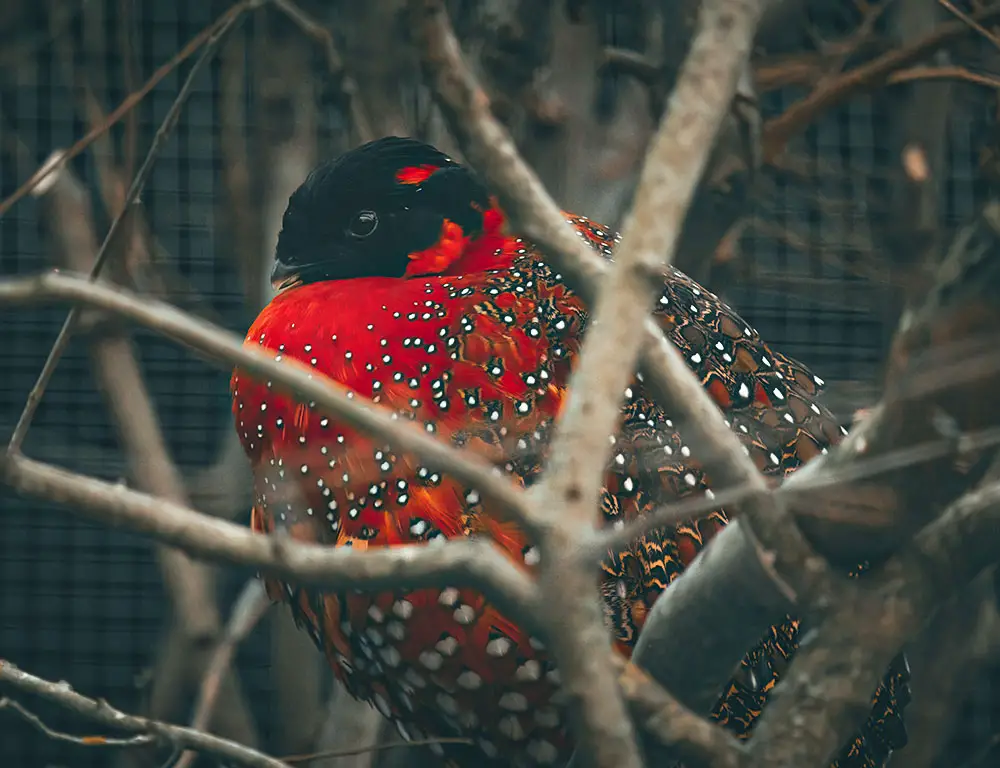
What Are the Key Physical Characteristics of the Satyr Tragopan?
The Satyr Tragopan is a pheasant species found in the Eastern Himalayas, particularly in parts of India, Nepal, Bhutan, and Tibet. This bird is renowned for its striking physical characteristics, which include vibrant plumage, unique facial features, and elaborate displays.
Let’s delve into the critical physical characteristics of the Satyr Tragopan:
Size and Shape
The Satyr Tragopan is a medium-sized bird, with males typically larger than females. On average, males measure around 63 to 70 centimeters (25 to 28 inches) in length, including their tail feathers, while females are slightly smaller. They have a robust build with a short, rounded tail.
Plumage
One of the most notable features of the Satyr Tragopan is its stunning plumage. Males display a striking combination of colors, including deep shades of maroon, blue, black, and white.
The back and wings are predominantly black with white spots, while the chest and belly are adorned with iridescent shades of blue and green. The most distinctive feature is the bright red and white pattern on the breast, resembling a flamboyant cape or bib.
Facial Features
The head of the Satyr Tragopan is adorned with several unique facial features. Both males and females have a small, fleshy, blue-colored skin patch around the eye.
However, it is the male’s facial ornamentation that genuinely stands out during the breeding season.
Males develop inflatable, bright blue-colored lappets or wattles on the sides of their necks, which they can inflate during courtship displays to impress females.
Crest
Another striking feature of the male Satyr Tragopan is its prominent crest. This crest consists of elongated feathers that form a horn-like structure on the top of the head.
The crest can be raised or lowered depending on the bird’s mood or behavior, and it adds to the overall majestic appearance of the bird.
Bill and Feet
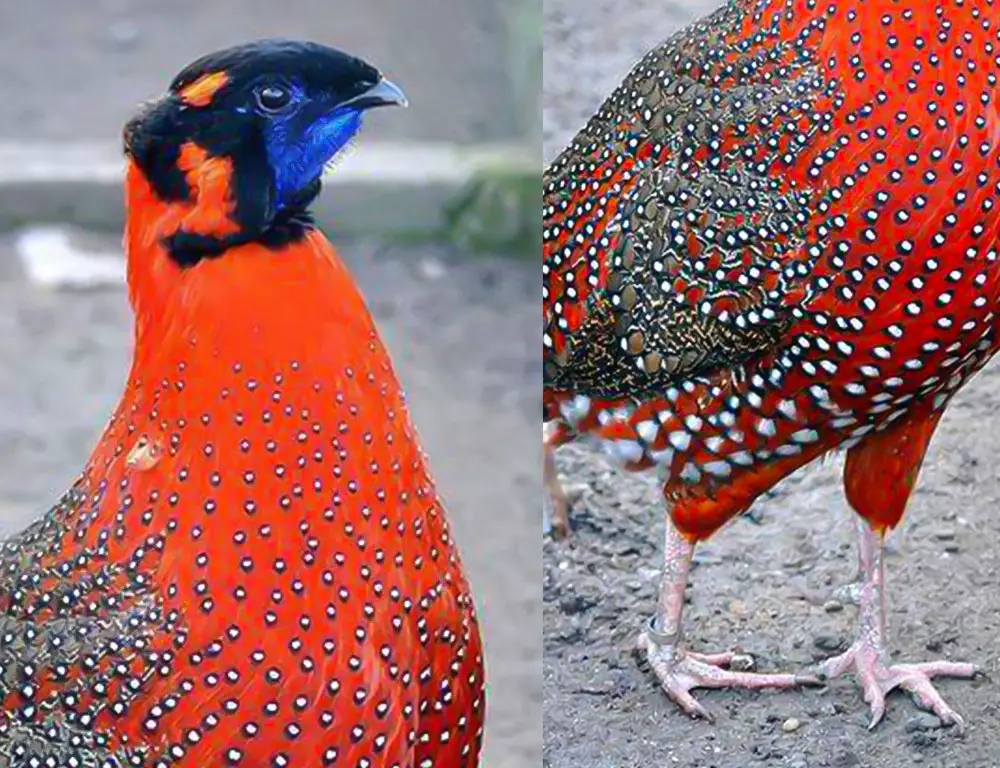
The bill of the Satyr Tragopan is short and stout, suited for feeding on various fruits, seeds, and insects. The feet are strong and adapted for perching and walking on uneven terrain, typical of their mountainous habitat.
Sexual Dimorphism
Like many bird species, there is significant sexual dimorphism between male and female Satyr Tragopans. Males exhibit vibrant and elaborate plumage, facial ornaments, and crest, which they use to attract mates during the breeding season.
In contrast, females have more subdued plumage, with shades of brown and gray, providing camouflage while nesting and caring for their young.
Behavioral Characteristics
In addition to their physical attributes, the Satyr Tragopan is known for its unique behaviors, especially during the breeding season.
Males engage in elaborate courtship displays, which involve inflating their neck wattles, erecting their crest, and emitting low-frequency vocalizations to attract females.
These displays are often accompanied by ritualized movements and postures to showcase their vitality and fitness.
A Deeper Look into the Life History of the Satyr Tragopan
The Satyr Tragopan belongs to the family Phasianidae, within the order Galliformes. Here’s a breakdown of its taxonomy:
Taxonomy Level
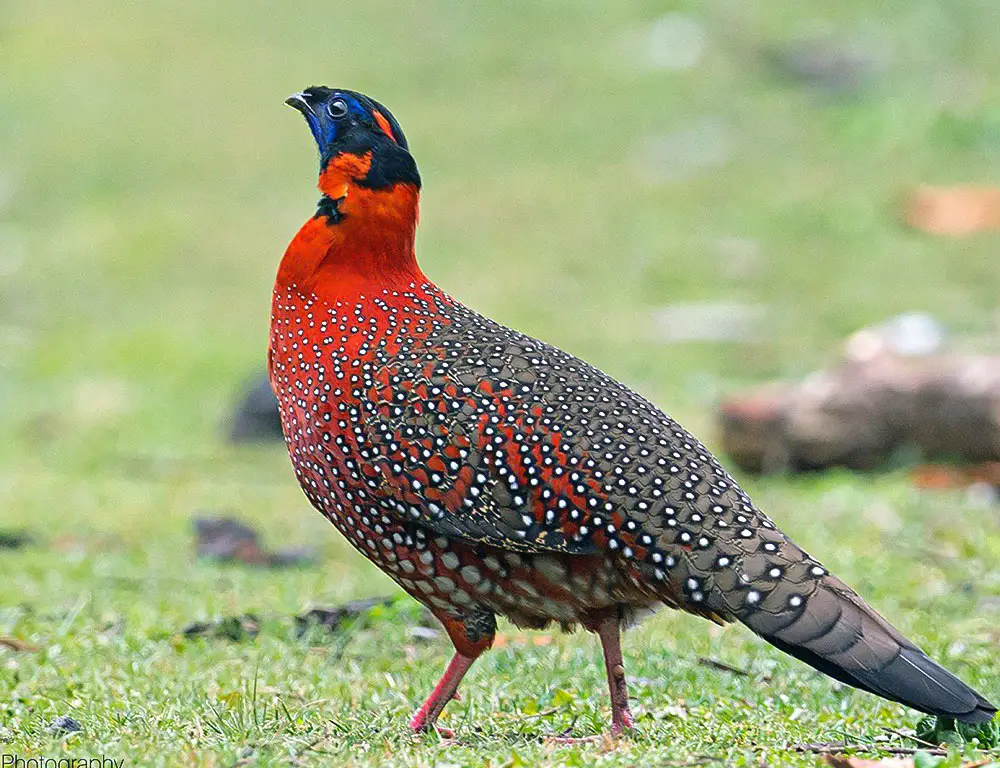
| Taxonomy Level | Classification |
| Kingdom | Animalia |
| Phylum | Chordata |
| Class | Aves |
| Order | Galliformes |
| Family | Phasianidae |
| Genus | Tragopan |
| Species | Tragopan satyra |
Food Habitat
Satyr Tragopans primarily feed on a varied diet of fruits, seeds, buds, leaves, and insects. They forage in the dense undergrowth of their forest habitats, using their stout bills to probe for food items on the forest floor and in low vegetation.
Nesting
Satyr Tragopans construct their nests on the ground, typically concealed among dense vegetation for protection against predators. The nest is a shallow depression lined with leaves, grass, and other plant materials. Here’s a summary of their nesting habits:
| Nesting Habit | Description |
| Nest Location | Ground, concealed in dense vegetation |
| Nest Composition | Leaves, grass, and plant materials |
| Clutch Size | Typically contains 3-6 eggs |
| Incubation Period | Around 24-25 days |
| Parental Care | Both male and female share incubation and care |
Breeding
Breeding in Satyr Tragopans typically occurs during the spring and early summer months. Males engage in elaborate courtship displays to attract females, which involve vocalizations, inflating their neck wattles, erecting their crest, and performing ritualized movements.
Once a female is attracted, the pair mates, and the female lays a clutch of eggs in the nest. Both parents share the responsibilities of incubating the eggs and caring for the chicks after hatching.
Range Map and Conservation Status of the Satyr Tragopan
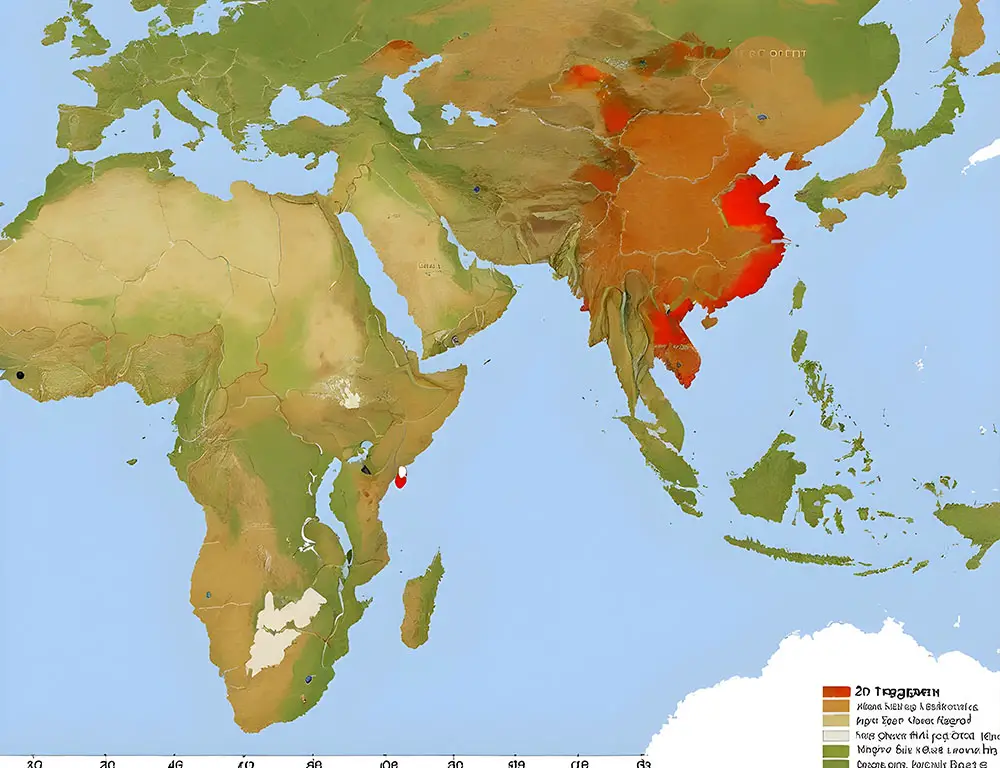
The Satyr Tragopan is primarily found in the Eastern Himalayas, spanning parts of India, Nepal, Bhutan, and Tibet. Here’s a detailed description of its range map and conservation status:
Range Map
The range of the Satyr Tragopan is concentrated in the montane forests of the Eastern Himalayas, characterized by rugged terrain and dense vegetation. Within this range, the species inhabits altitudes ranging from 2,000 to 4,500 meters above sea level.
The distribution of the Satyr Tragopan within its range is influenced by factors such as habitat quality, availability of food resources, and nesting sites.
Conservation Status
The Satyr Tragopan faces several threats to its survival, primarily due to habitat loss, degradation, and fragmentation.
Human activities such as deforestation, agriculture, and infrastructure development have led to the loss of its forest habitat, restricting its range and reducing population numbers.
Additionally, the species is vulnerable to poaching for its feathers and meat and is a target for the illegal pet trade.
As a result of these threats, the Satyr Tragopan is classified as “Near Threatened” on the International Union for Conservation of Nature (IUCN) Red List of Threatened Species.
This designation highlights the urgent need for conservation action to protect the species and its habitat.
Conservation efforts focus on habitat preservation, anti-poaching measures, community engagement, and research to better understand the ecology and behavior of the Satyr Tragopan.
What Are the Common Diseases and Treatments of the Satyr Tragopan?
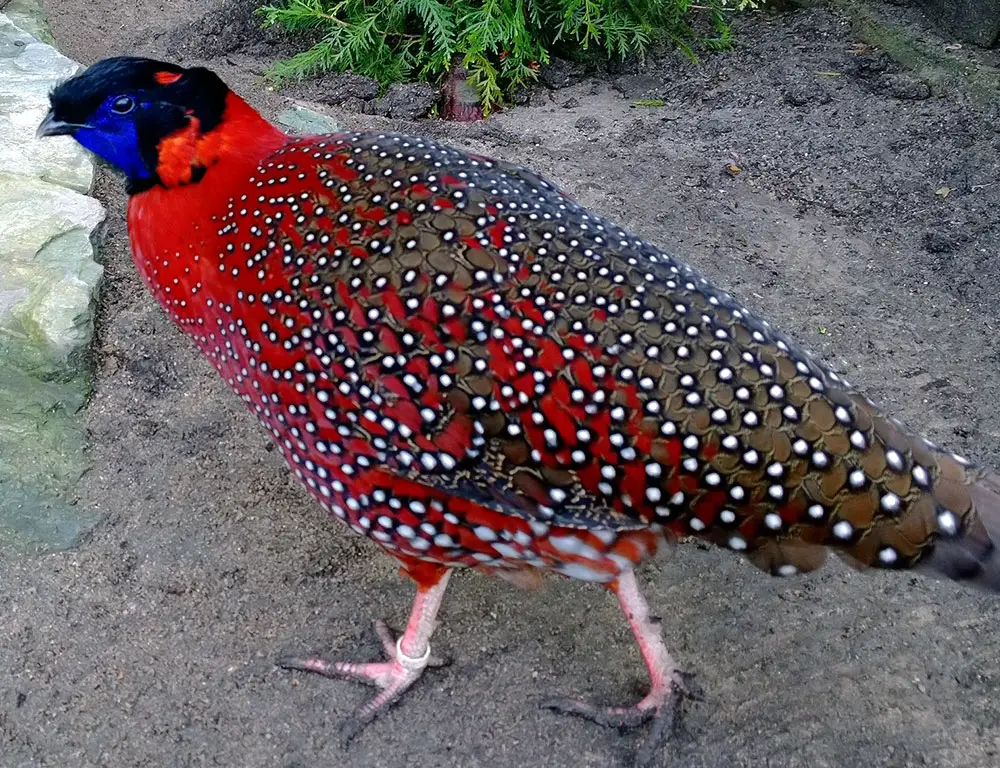
As with wild bird species, Satyr Tragopans are susceptible to various diseases and health issues. While specific information on the diseases that affect Satyr Tragopans may be limited, some common avian ailments and treatments can be generalized:
Respiratory Infections
Like many birds, Satyr Tragopans can be vulnerable to respiratory infections caused by bacteria, viruses, or fungi. Symptoms may include nasal discharge, difficulty breathing, and lethargy.
Treatment typically involves antibiotics or antifungal medications prescribed by a veterinarian.
Parasitic Infections
External parasites such as mites and lice, as well as internal parasites like worms, can affect the health of Satyr Tragopans. Regular monitoring and treatment with appropriate parasiticides can help control infestations.
Nutritional Deficiencies
Inadequate diet or improper nutrition can lead to health problems in Satyr Tragopans, including deficiencies in essential vitamins and minerals. A balanced and varied diet, supplemented if necessary, can help prevent nutritional deficiencies.
Injuries
Satyr Tragopans may sustain injuries from encounters with predators, accidents, or territorial disputes. Prompt veterinary care may be required to treat wounds, fractures, or other injuries.
Reproductive Issues
Breeding Satyr Tragopans may experience reproductive problems such as egg binding or infertility. Veterinary intervention may be necessary to address these issues and improve breeding success.
Viral Diseases
Certain viral diseases, such as avian influenza or Newcastle disease, can risk Satyr Tragopans. Vaccination against specific viral pathogens and biosecurity measures to prevent disease transmission can help mitigate the risk.
Stress-related Conditions
Stressful environmental conditions or captivity-related stress can weaken the immune system of Satyr Tragopans, making them more susceptible to diseases.
Providing appropriate habitat, enrichment, and minimizing stressors can help maintain their health and well-being.
5 Interesting Facts About the Satyr Tragopan
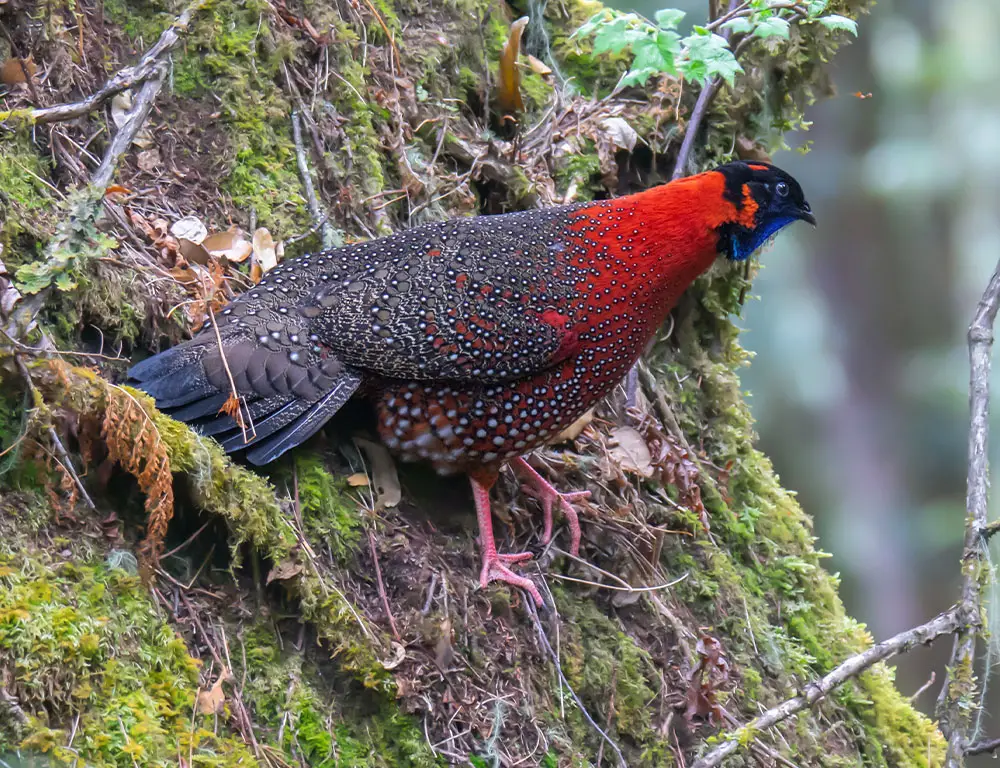
Let’s explore some fun facts about the fascinating Satyr Tragopan.
1. Elaborate Courtship Displays
Male Satyr Tragopans perform intricate courtship displays during the breeding season to attract females. This includes inflating their blue neck wattles, erecting their crest, and vocalizing while displaying colorful plumage, making for a captivating spectacle.
2. Unique Facial Ornamentation
Both male and female Satyr Tragopans have a small, fleshy, blue-colored skin patch around their eyes.
However, during the breeding season, males develop inflatable, bright blue-colored lappets or wattles on their necks, enhancing their striking appearance.
3. Masterful Mimics
Satyr Tragopans are known for their ability to mimic sounds from their environment, including the calls of other bird species. This behavior serves various purposes, from communication to defense against predators.
4. Montane Habitat Dwellers
Satyr Tragopans inhabit montane forests in the Eastern Himalayas, thriving in rugged terrain at altitudes ranging from 2,000 to 4,500 meters above sea level.
Their natural habitat consists of dense undergrowth and scrub, where they forage for food and seek shelter.
5. Limited Distribution
Despite their striking appearance and captivating behaviors, Satyr Tragopans have a relatively restricted distribution.
They are primarily found in parts of India, Nepal, Bhutan, and Tibet within the Eastern Himalayas, making sightings of these elusive birds a rare and cherished experience for birdwatchers and nature enthusiasts.
FAQs
What is a Satyr Tragopan?
The Satyr Tragopan (Tragopan satyra) is a pheasant species in the Eastern Himalayas. It is known for its vibrant plumage and elaborate courtship displays.
What does a Satyr Tragopan eat?
Satyr Tragopans have a varied diet that includes fruits, seeds, buds, leaves, and insects. They forage in the dense undergrowth of their forest habitats.
Where does the Satyr Tragopan live?
Satyr Tragopans inhabit montane forests in the Eastern Himalayas, ranging from 2,000 to 4,500 meters above sea level. Their habitat consists of rugged terrain with dense vegetation.
Is the Satyr Tragopan endangered?
The Satyr Tragopan is classified as “Near Threatened” on the IUCN Red List of Threatened Species. It faces threats such as habitat loss, poaching, and fragmentation of its forest habitat.
How does the Satyr Tragopan attract mates?
Male Satyr Tragopans attract mates through elaborate courtship displays, which involve inflating their neck wattles, erecting their crest, and vocalizing while displaying their colorful plumage.
Conclusion
The Satyr Tragopan stands as a testament to the evolutionary marvels found within the natural world. Through our exploration, we have discovered the profound ecological significance of this species, as it plays a vital role in the delicate balance of its mountainous habitats.
However, alongside its awe-inspiring presence comes the looming threat of habitat loss, poaching, and climate change.
As stewards of the Earth, we must take decisive action to protect and conserve the Satyr Tragopan and its fragile ecosystem.
By implementing effective conservation measures, such as habitat preservation, community engagement, and sustainable practices, we can ensure the continued survival of this magnificent bird for generations to come.
Let us admire the Satyr Tragopan for its captivating beauty and champion its cause, advocating for the preservation of all species, great and small, that grace our planet with their presence.